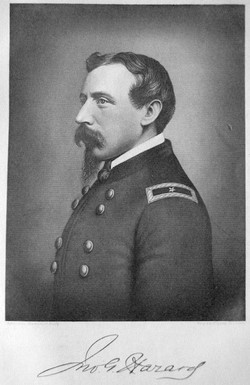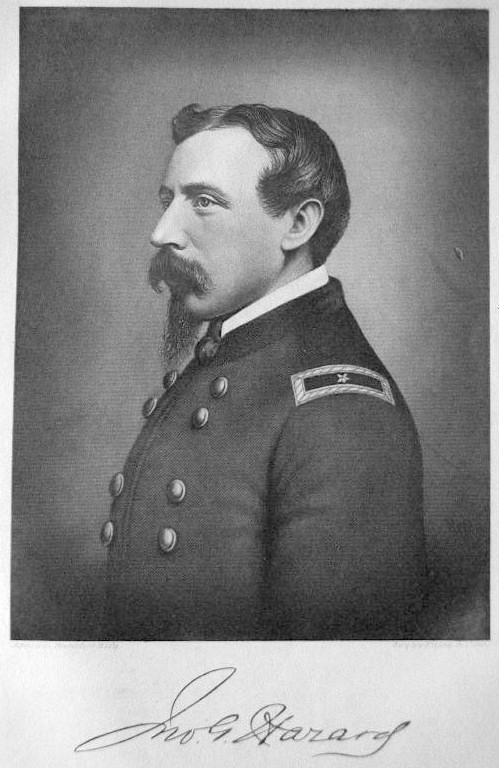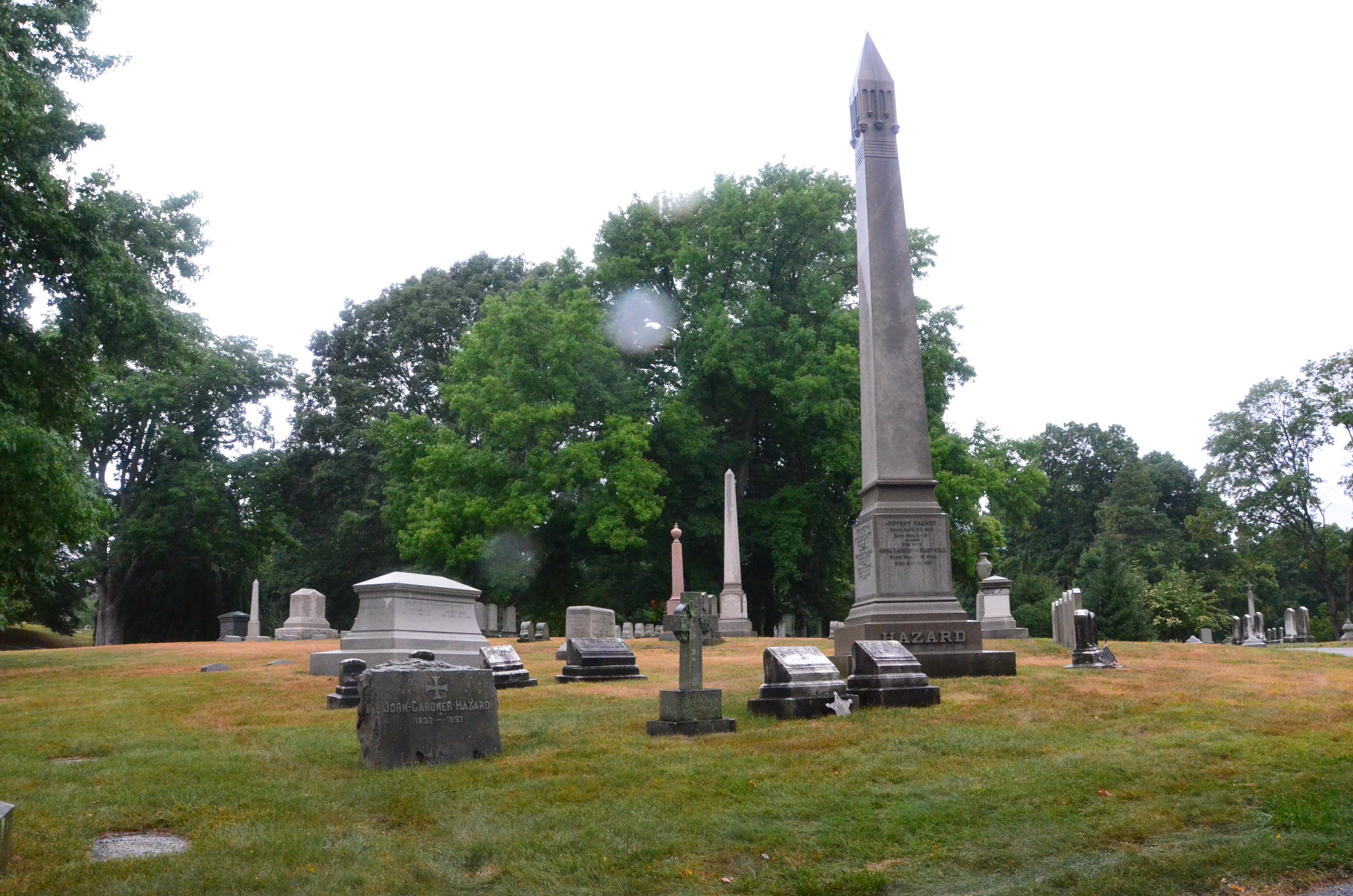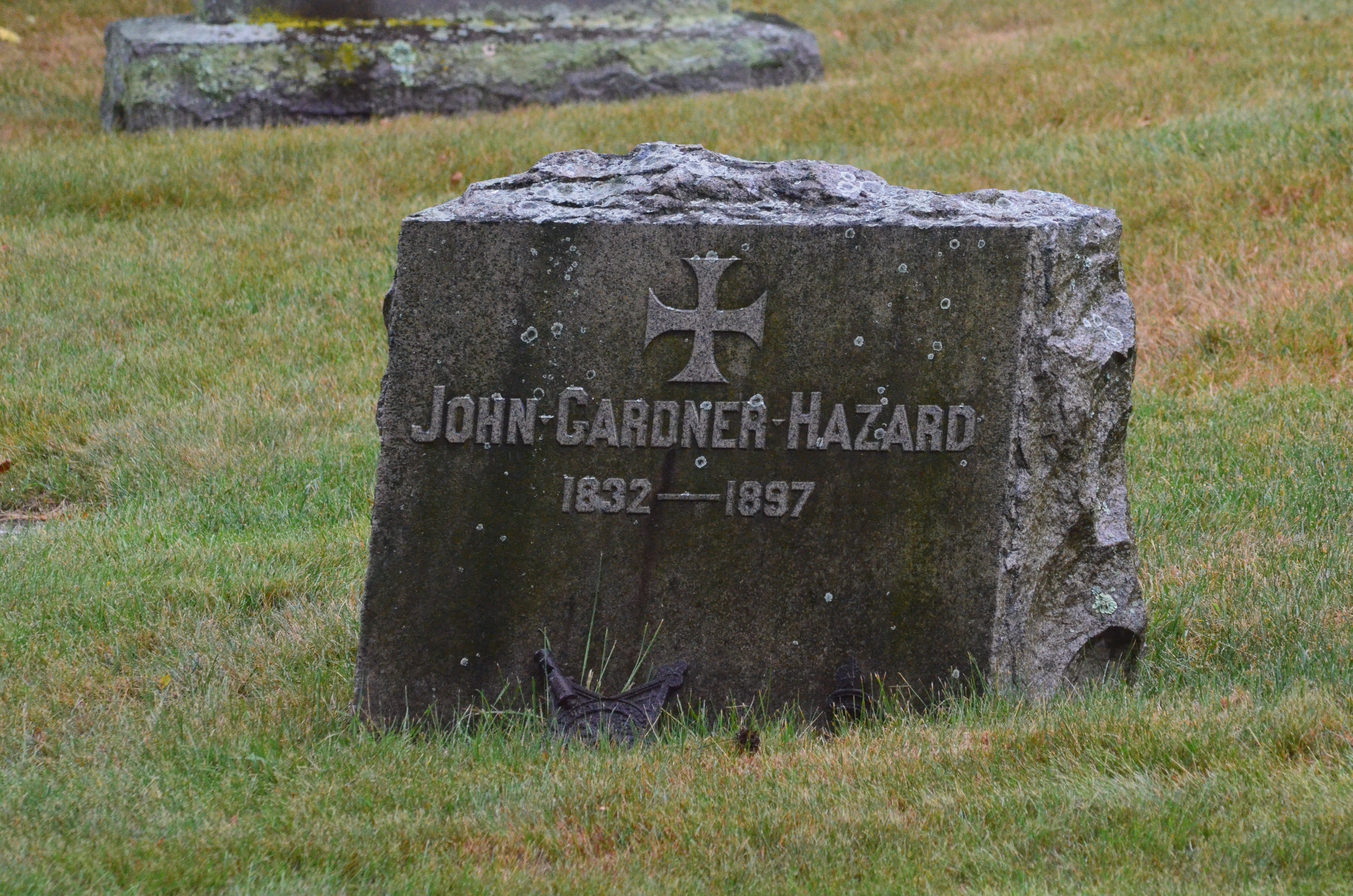(Crandall) Hazard, was born April 15, 1832, in the town of
Exeter, R. I., died May 15, 1897, in Providence. He was one
of Rhode Island's foremost citizen-soldiers. The breaking out
of the Civil War found him engaged in mercantile pursuits at
Providence. His patriotism and the stirring events of the
spring and summer of 1861 led him to tender his services to
his country. He was commissioned first lieutenant, First
Rhode Island Artillery, August 8, 1861; assisted in the
organization of Batteries B and C; accompanied the latter to
Washington, and was soon after transferred to Battery A. He
was ordered to accompany General Williams' brigade to Ball's
Bluff on the day of the battle there, and arrived on the
ground at daylight the following morning. The day was spent
in getting canal boats in readiness, and putting on board the
battery and horses. After dark he was ordered to unship, as
the troops already across were ordered back to Maryland's side
of the Potomac. This move of crossing to the Virginia side of
the river was simply a feint to prevent the enemy making
another, prior to our troops returning, which could only be
done under cover of night. The following day the battery
returned to its old camping ground at Darnstown. About the
first of November, Lieutenant Hazard was ordered to report to
General Charles P. Stone, at Poolesville, Md., where his
battery remained during the winter, sending out a section
weekly to do picket duty. During the great portion of the
winter Lieutenant Hazard was in command of the battery,
Captain Tompkins being absent on sick leave. Early in the
spring the battery accompanied General Sedgewick to Harper's
Ferry, from which point two or three expeditions were made up
the valley to Charlestown and Winchester, resulting only in
slight skirmishes. In April the battery was ordered to
Washington to ship for Fortess Monroe. Arriving at that
point, the division was united to Sumner's Corps, the Second.
Lieutenant Hazard accompanied the battery up the peninsula,
and was almost daily engaged in the siege of Yorktown. At the
raising of the siege it was put on shipboard on the York river
and landed at West Point, where it joined the main part of the
army again at Camp Winfield Scott. June 30, crossing the
Chickahominy, it was engaged in the battle at Fair Oaks, after
which it remained in this work until the retreat was ordered
to the James river. The battery was engaged almost
constantly, as was the entire army, from the time it started
until it reached the river, - more severely for the battery,
perhaps, at Peach Orchard, White Oak Swamp and Glendale. At
Malvern Hill it was not ordered into the fight, yet sustained
loss from the enemy's artillery.
On August 20, 1862, Lieutenant Hazard was commissioned captain
of Battery B, and took command September 1, at Alexandria, on
its arrival from the peninsula. It then rejoined the Second
Corps, and accompanied it through Maryland, South Mountain,
thence to the battle of Antietam. From here the army went
into camp in and about Harper's Ferry, to refit and
reorganize. The battery at this time was in a particularly bad
condition, horses worn out, men were ragged, and from constant
marching day and night, the men had become slack in
discipline. These evils, with the assistance of Lieutenant
George W. Adams, Horace S. Bloodgood and G. Lyman Dwight, were
speedily overcome. In October, 1862, Captain Hazard proceeded
with the army to Warrenton, and from there, after the change
in command to Falmouth, opposite Fredericksburg, where the
battery remained in camp until ordered into the battle of
Fredericksburg. On the 12th he was engaged from daylight
until late in the day in shelling the same. On the morning of
the 13th he was ordered across the river to report to Major-
General O. O. Howard, commanding Second Division of the corps.
The infantry having been repulsed again and again by many hard
hours of fighting, it was decided to send Battery B to the
extreme front in a very exposed position, within one hundred
and fifty yards of the enemy's line and under a heavy
crossfire of their artillery. Their orders were to go in on
the run or they would never succeed in getting into position
at all. They did so, but remained there only about twenty
minutes, when they were ordered out, with a severe loss of men
and horses. General Couch afterward told Captain Hazard that
he did not expect to see him get out without losing his
command, but that he considered the sacrifice called for, as
the infantry were getting much demoralized. The horses of
Captain Hazard and Lieutenant Bloodgood were shot under them
during the battle.
In April, 1863, Captain Hazard was made chief of artillery of
the corps. At the same time a complete change was made in the
organization of the artillery of the Army of the Potomac. The
artillery of each corps was taken from the division and made
into a separate brigade by itself, and placed under the sole
command of the chief of artillery, who was made, by the order,
a brigade commander. After the fatal blunder of General
Hooker, at Chancellorsville, the enemy left our front on their
memorable campaign into Maryland and Pennsylvania. Captain
Hazard's brigade accompanied the Second Corps on the chase
after Lee to the battle of Gettysburg, where, after three
days' terrific fighting, Lee retreated across the Potomac.
After following him to Falling Waters our army was put in
motion for Virginia, and struck the enemy again near Culpeper.
The Second Corps had been in a severe fight with a portion of
the enemy at Auburn Hill and Bristoe Station, Captain Hazard's
command taking a very important part in the result of the day.
Soon after, the army went into winter quarters on the Rapidan.
In April, 1864, Captain Hazard was made major of his regiment,
and assigned to the command of the Second Brigade of the
Artillery Reserves. When the army broke camp on the 4th of
May, he accompanied his brigade to the Wilderness; thence to
Spottsylvania, where the brigade was attached to that part of
General Tidball's, of the Second Corps, with which he
continued through the battle of the Po, Mattapony, North Anna
and Cold Harbor, to Petersburg. On July 1, 1864, General
Tidball was ordered to West Point as Commander, and the
consolidated brigade was placed under Major Hazard's command.
The brigade was engaged almost daily from May 5 until August
1; from that time, until about September 1, it remained quiet,
with the exception of the battle of Deep Bottom, and the
unfortunate repulse at Ream's Station, where he lost eight
guns and all the officers of Battery B, captured by the enemy.
On August 8, Major Hazard was made lieutenant-colonel by
brevet, for 'gallant and meritorious services'. During the
fall and winter of 1864 his command occupied various forts in
the works in front of Petersburg, at times withdrawing a few
batteries for some of the winter. Most of the time he
occupied the line, Colonel Hazard had in his command nineteen
light, four heavy and six mortar batteries, stationed at the
most important points and requiring the greatest care and
watchfulness. On March 28 the brigade broke camp and moved
with the corps across Hatcher's Run, where they engaged the
enemy, in connection with the grand advance of the whole army.
Richmond and Petersburg falling, they pursued the enemy to
Appomattox Court House, their corps being immediately on the
heels of Lee's army. They were constantly skirmishing with
them to the very hour of their surrender. The last battle
engaged in was at Farmersville, April 7 and 8. On May 3,
1865, Lieutenant-Colonel Hazard was made colonel and
brigadier-general by brevet 'for meritorious service during
the war'. He was recommended for these brevets by his
superior officers several months prior. He accompanied his
brigade from Virginia to Washington, and participated in the
Grand Review. At the disbanding of the artillery, he was
ordered to report with his regiment (Colonel Tompkins having
been mustered out) to Rhode Island, and on July 1 was mustered
out. On July 11, General Hazard was commissioned colonel of
the Fifth United States Volunteers, retaining his brevet rank
of brigadier-general, and ordered by the Secretary of War to
make his headquarters at Fort Wadsworth, S. I., New York
harbor, and he commanded that post until March 9, 1866, when
his regiment was mustered out of service. After the war the
greater part of the active business life of General Hazard was
passed in the South, making his headquarters at New Orleans,
engaged in the cotton business. He made a number of business
trips abroad.
General Hazard died May 15, 1897, in Providence, R. I. His
funeral took place from Grace Episcopal Church, May 18, there
being present besides friends a large representation of the
Loyal Legion, of which the deceased had been a member. The
interment was at Swan Point Cemetery, Providence. The
Providence 'Daily Journal', in its issue for May 19, 1897,
said:
'The reputation which General Hazard earned by his valor
during the struggle of the Rebellion was well sustained by his
upright life in the time of peace which followed its close.
That he held the love and respect of all who knew him was
fully evidenced by the large number of friends who gathered in
the church to pay the last tribute possible to the deceased.'
The Providence 'News', for May 18, 1897, also paid him a
tribute:
'The late John Gardiner Hazard, to whose memory the last
tribute are to-day paid, was one of Rhode Island's gallant
soldiers during the War of the Rebellion, and though his
business career was made outside the home boundaries, he had a
large acquaintance here and was greatly liked and esteemed in
many circles. His sudden death was a shock to these many
friends, for though the severe service of the soldier had
undoubtedly had its effects on his physical constitution, he
had all the spirit of young manhood, and was a charming
associate wherever he moved.'
(Crandall) Hazard, was born April 15, 1832, in the town of
Exeter, R. I., died May 15, 1897, in Providence. He was one
of Rhode Island's foremost citizen-soldiers. The breaking out
of the Civil War found him engaged in mercantile pursuits at
Providence. His patriotism and the stirring events of the
spring and summer of 1861 led him to tender his services to
his country. He was commissioned first lieutenant, First
Rhode Island Artillery, August 8, 1861; assisted in the
organization of Batteries B and C; accompanied the latter to
Washington, and was soon after transferred to Battery A. He
was ordered to accompany General Williams' brigade to Ball's
Bluff on the day of the battle there, and arrived on the
ground at daylight the following morning. The day was spent
in getting canal boats in readiness, and putting on board the
battery and horses. After dark he was ordered to unship, as
the troops already across were ordered back to Maryland's side
of the Potomac. This move of crossing to the Virginia side of
the river was simply a feint to prevent the enemy making
another, prior to our troops returning, which could only be
done under cover of night. The following day the battery
returned to its old camping ground at Darnstown. About the
first of November, Lieutenant Hazard was ordered to report to
General Charles P. Stone, at Poolesville, Md., where his
battery remained during the winter, sending out a section
weekly to do picket duty. During the great portion of the
winter Lieutenant Hazard was in command of the battery,
Captain Tompkins being absent on sick leave. Early in the
spring the battery accompanied General Sedgewick to Harper's
Ferry, from which point two or three expeditions were made up
the valley to Charlestown and Winchester, resulting only in
slight skirmishes. In April the battery was ordered to
Washington to ship for Fortess Monroe. Arriving at that
point, the division was united to Sumner's Corps, the Second.
Lieutenant Hazard accompanied the battery up the peninsula,
and was almost daily engaged in the siege of Yorktown. At the
raising of the siege it was put on shipboard on the York river
and landed at West Point, where it joined the main part of the
army again at Camp Winfield Scott. June 30, crossing the
Chickahominy, it was engaged in the battle at Fair Oaks, after
which it remained in this work until the retreat was ordered
to the James river. The battery was engaged almost
constantly, as was the entire army, from the time it started
until it reached the river, - more severely for the battery,
perhaps, at Peach Orchard, White Oak Swamp and Glendale. At
Malvern Hill it was not ordered into the fight, yet sustained
loss from the enemy's artillery.
On August 20, 1862, Lieutenant Hazard was commissioned captain
of Battery B, and took command September 1, at Alexandria, on
its arrival from the peninsula. It then rejoined the Second
Corps, and accompanied it through Maryland, South Mountain,
thence to the battle of Antietam. From here the army went
into camp in and about Harper's Ferry, to refit and
reorganize. The battery at this time was in a particularly bad
condition, horses worn out, men were ragged, and from constant
marching day and night, the men had become slack in
discipline. These evils, with the assistance of Lieutenant
George W. Adams, Horace S. Bloodgood and G. Lyman Dwight, were
speedily overcome. In October, 1862, Captain Hazard proceeded
with the army to Warrenton, and from there, after the change
in command to Falmouth, opposite Fredericksburg, where the
battery remained in camp until ordered into the battle of
Fredericksburg. On the 12th he was engaged from daylight
until late in the day in shelling the same. On the morning of
the 13th he was ordered across the river to report to Major-
General O. O. Howard, commanding Second Division of the corps.
The infantry having been repulsed again and again by many hard
hours of fighting, it was decided to send Battery B to the
extreme front in a very exposed position, within one hundred
and fifty yards of the enemy's line and under a heavy
crossfire of their artillery. Their orders were to go in on
the run or they would never succeed in getting into position
at all. They did so, but remained there only about twenty
minutes, when they were ordered out, with a severe loss of men
and horses. General Couch afterward told Captain Hazard that
he did not expect to see him get out without losing his
command, but that he considered the sacrifice called for, as
the infantry were getting much demoralized. The horses of
Captain Hazard and Lieutenant Bloodgood were shot under them
during the battle.
In April, 1863, Captain Hazard was made chief of artillery of
the corps. At the same time a complete change was made in the
organization of the artillery of the Army of the Potomac. The
artillery of each corps was taken from the division and made
into a separate brigade by itself, and placed under the sole
command of the chief of artillery, who was made, by the order,
a brigade commander. After the fatal blunder of General
Hooker, at Chancellorsville, the enemy left our front on their
memorable campaign into Maryland and Pennsylvania. Captain
Hazard's brigade accompanied the Second Corps on the chase
after Lee to the battle of Gettysburg, where, after three
days' terrific fighting, Lee retreated across the Potomac.
After following him to Falling Waters our army was put in
motion for Virginia, and struck the enemy again near Culpeper.
The Second Corps had been in a severe fight with a portion of
the enemy at Auburn Hill and Bristoe Station, Captain Hazard's
command taking a very important part in the result of the day.
Soon after, the army went into winter quarters on the Rapidan.
In April, 1864, Captain Hazard was made major of his regiment,
and assigned to the command of the Second Brigade of the
Artillery Reserves. When the army broke camp on the 4th of
May, he accompanied his brigade to the Wilderness; thence to
Spottsylvania, where the brigade was attached to that part of
General Tidball's, of the Second Corps, with which he
continued through the battle of the Po, Mattapony, North Anna
and Cold Harbor, to Petersburg. On July 1, 1864, General
Tidball was ordered to West Point as Commander, and the
consolidated brigade was placed under Major Hazard's command.
The brigade was engaged almost daily from May 5 until August
1; from that time, until about September 1, it remained quiet,
with the exception of the battle of Deep Bottom, and the
unfortunate repulse at Ream's Station, where he lost eight
guns and all the officers of Battery B, captured by the enemy.
On August 8, Major Hazard was made lieutenant-colonel by
brevet, for 'gallant and meritorious services'. During the
fall and winter of 1864 his command occupied various forts in
the works in front of Petersburg, at times withdrawing a few
batteries for some of the winter. Most of the time he
occupied the line, Colonel Hazard had in his command nineteen
light, four heavy and six mortar batteries, stationed at the
most important points and requiring the greatest care and
watchfulness. On March 28 the brigade broke camp and moved
with the corps across Hatcher's Run, where they engaged the
enemy, in connection with the grand advance of the whole army.
Richmond and Petersburg falling, they pursued the enemy to
Appomattox Court House, their corps being immediately on the
heels of Lee's army. They were constantly skirmishing with
them to the very hour of their surrender. The last battle
engaged in was at Farmersville, April 7 and 8. On May 3,
1865, Lieutenant-Colonel Hazard was made colonel and
brigadier-general by brevet 'for meritorious service during
the war'. He was recommended for these brevets by his
superior officers several months prior. He accompanied his
brigade from Virginia to Washington, and participated in the
Grand Review. At the disbanding of the artillery, he was
ordered to report with his regiment (Colonel Tompkins having
been mustered out) to Rhode Island, and on July 1 was mustered
out. On July 11, General Hazard was commissioned colonel of
the Fifth United States Volunteers, retaining his brevet rank
of brigadier-general, and ordered by the Secretary of War to
make his headquarters at Fort Wadsworth, S. I., New York
harbor, and he commanded that post until March 9, 1866, when
his regiment was mustered out of service. After the war the
greater part of the active business life of General Hazard was
passed in the South, making his headquarters at New Orleans,
engaged in the cotton business. He made a number of business
trips abroad.
General Hazard died May 15, 1897, in Providence, R. I. His
funeral took place from Grace Episcopal Church, May 18, there
being present besides friends a large representation of the
Loyal Legion, of which the deceased had been a member. The
interment was at Swan Point Cemetery, Providence. The
Providence 'Daily Journal', in its issue for May 19, 1897,
said:
'The reputation which General Hazard earned by his valor
during the struggle of the Rebellion was well sustained by his
upright life in the time of peace which followed its close.
That he held the love and respect of all who knew him was
fully evidenced by the large number of friends who gathered in
the church to pay the last tribute possible to the deceased.'
The Providence 'News', for May 18, 1897, also paid him a
tribute:
'The late John Gardiner Hazard, to whose memory the last
tribute are to-day paid, was one of Rhode Island's gallant
soldiers during the War of the Rebellion, and though his
business career was made outside the home boundaries, he had a
large acquaintance here and was greatly liked and esteemed in
many circles. His sudden death was a shock to these many
friends, for though the severe service of the soldier had
undoubtedly had its effects on his physical constitution, he
had all the spirit of young manhood, and was a charming
associate wherever he moved.'
Family Members
Advertisement
Explore more
Sponsored by Ancestry
Advertisement








